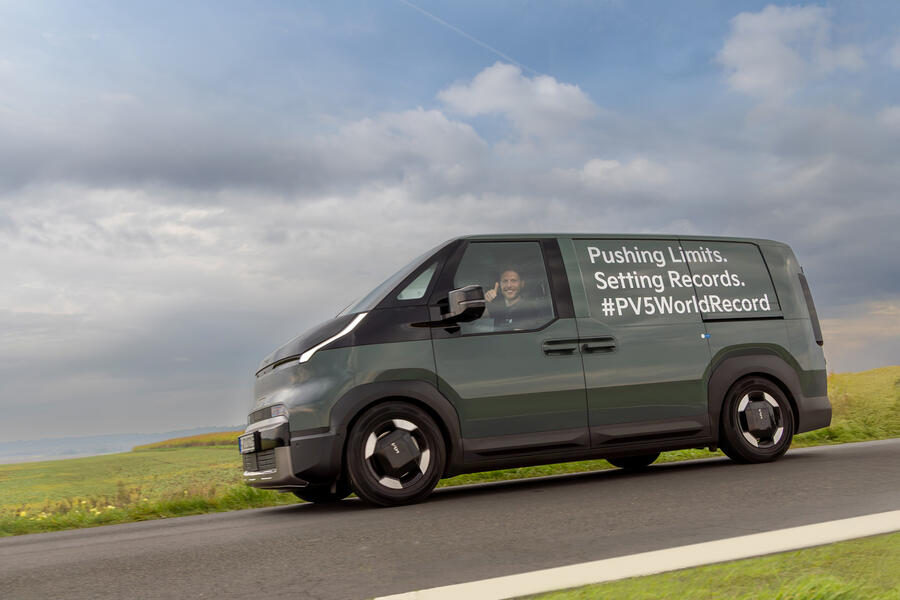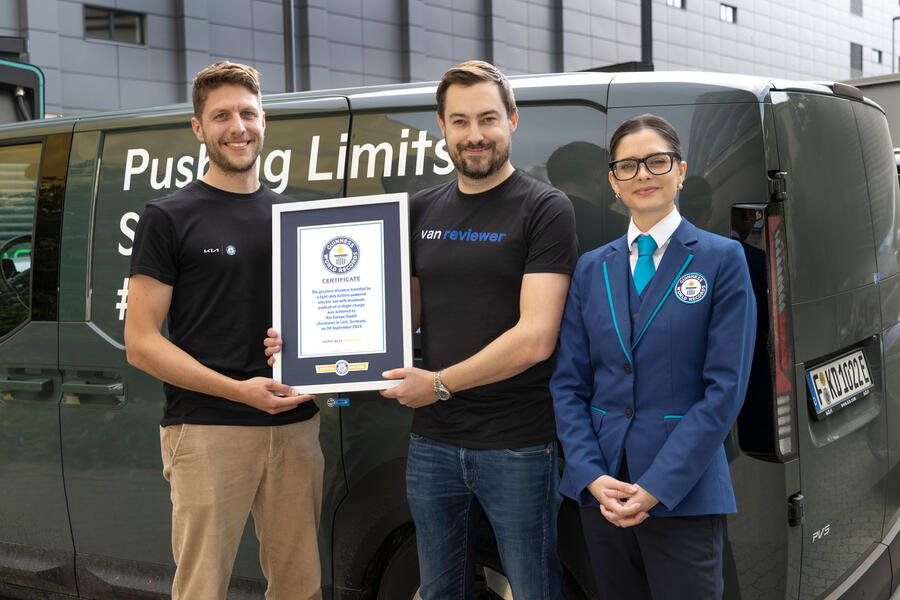Kia’s new electric van almost doubled its WLTP range during the run
New electric van travels more than 430 miles on public roads with 690kg of cargo – and we were driving
Kia has set a world record for the greatest distance travelled by an electric van on a single charge with a payload.
The Kia PV5 travelled a total of 430.84 miles (693.38km) on a single charge with a full payload of 690kg on board.
The record run took place on public roads north of Frankfurt, Germany, over a route chosen to replicate the daily working life of a delivery van.
At the wheel was Christopher Nigemeier, a member of the PV5’s development team, and Van Reviewer editor George Barrow, who together drove 11 full laps of a 36.2-mile loop before eventually stopping on the 12th.
The route included small towns and villages with roundabouts, traffic lights and stop signs, as well as the everyday traffic normally encountered during more than 22 hours of driving.
With a combined range of 258 miles according to the WLTP combined test cycle (which is evaluated without a payload), the PV5 managed to average 6mpkWh from its 71.2kWh battery.
The van and its drivers also managed to achieve more than double the minimum requirement from Guinness World Records for the attempt, which was set at 300km (186 miles).
Internal tests by Kia had shown that for every additional 100kg of payload in the van, its range would reduce by only around 1.5%.
Speaking after the world record attempt, Marc Hedrich, president and CEO of Kia Europe, said: “The fact that much of our target audience for this van variant could operate for almost two full working days on a single charge speaks volumes about its real-world capability.”
Nigemeier, senior engineer at Hyundai Motor Europe Technical Center, added: “As an engineer, this challenge was both technical and personal.
“George brought an incredible amount of driving experience from testing other vans, while I had the advantage of knowing the PV5’s powertrain inside out.
“It became a friendly competition between us, who could squeeze the most out of each kilowatt-hour. In the end, it was the vehicle itself that impressed us both.”
Behind the wheel of a Guinness World Record
It’s not every day you get to attempt to set a Guinness World Record, and having been fascinated by the thought since reading the 1999 edition of the book and being mesmerised by the accompanying TV show, this was an opportunity I couldn’t turn down. But how long exactly would depleting a battery from 100% to 0% actually take?

A lot longer than expected, it turns out. Using Kia’s own payload calculations, I knew that the maximum payload should theoretically reduce the range by just 10.5%. That would bring the adjusted WLTP combined range for the PV5 to just 230 miles, but by maximising the range with a repertoire of economy driving tricks, the true number would be something of an unknown.
One thing was for certain, it was likely to be crushingly boring – and, dare I say, uncomfortable.
After scrutineering by independent inspectors from TÜV Hessen and Buck Vermessung, as well as a Guinness World Records adjudicator, the attempt began.
Minimising harsh acceleration and braking is the key to good economy, so as I crept out onto the road, I was pleasantly surprised to find a gradual downward slope. We slowly built up speed as the indicated range crept up, as the computer adjusted itself to the new reality of travelling at half of the German speed limit. After one lap, which took just under two hours, it was clear that this attempt was going to take a lot longer than anyone might have imagined.
It was also my first time experiencing the route. I’d done some light reconnaissance with satellite images and maps, while my co-driver Chris informed me he’d put the route through running app Strava and discovered there were more than 370m of elevation changes. Some of those ascents were brutal, battery-sapping affairs with long, sustained slopes that would make a cyclist’s knees tremble.
The descents were also less than ideal, often extremely steep, and many of them had sharp bends and ended in little villages with speed limits, ruining the chance to coast through them. Careful use of the three levels of regenerative braking were needed, along with huge amounts of concentration to navigate the scores of roundabouts, traffic lights and junctions without coming to a stop.

It didn’t always work, but after more than 22 hours of astonishingly comfortable driving and nearly 30km on an indicated 0% battery, I turned the van through a (by then extremely familiar) junction and found myself unable to accelerate. The van remained temporarily stuck at 20kph, and then nothing. The motor stopped and we coasted to a gentle halt.
The attempt was over and the PV5 had secured a Guinness World Records title for ‘the greatest distance travelled by a light-duty battery-powered electric van with maximum payload on a single charge’, earning a deserved place in the record books alongside the person with the world’s longest fingernails.
George Barrow is the editor of van reviews website Van Reviewer and the UK jury member for the International Van of the Year Award.
Source: Autocar
